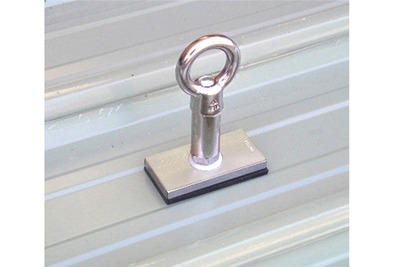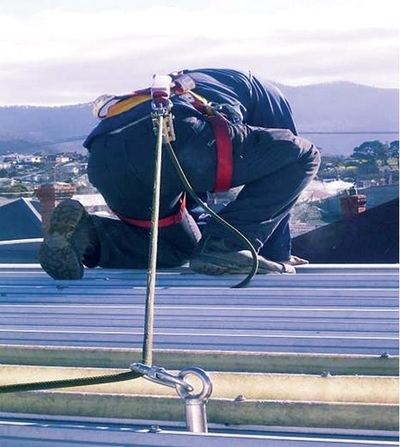Development of Australian Standard for single point anchors
Sunday, 14 April, 2013
The Working at Height Association has funded the development of an Australia Standard for the manufacture and test of single point anchors through Standards Australia. Gordon Cadzow, Secretary, WAHA, provides all the background and progress of this standard and the critical next step to ensure properly functioning fall arrest systems.
When the use of the hierarchy of control indicates that there are no options other than to conduct work at height, the use of personal fall protection equipment is the last form of protection against potential accidents.
Each component within a fall protection system must be designed to manage the huge forces involved in arresting the fall of a person working at height and, together, they must work flawlessly to ensure the overall system is effective.
Where a personal fall protection system is required, there are three key elements:
- Full body, fall arrest rated, harness.
- A fall arrest rated anchor system.
- A shock absorbing connector to join the full body harness to the anchor system (usually a shock-absorbing lanyard or a self-retracting lifeline).
Over the last 10 years, Australia has developed what is recognised as the world’s most comprehensive suite of standards covering personal fall protection equipment - known as the AS/NZS1891 suite of standards.
The first three parts of the standard cover the product design and testing standards. The first of those covers harnesses and ancillary equipment (harnesses, lanyards, pole straps, etc), the second (which is in two sections) covers horizontal lifeline and rail systems while the third is directed at fall arrest devices (rope grabs, etc).
Part 4 is directed at the users of the equipment and focuses on the selection, use and maintenance of fall arrest equipment certified to the design and testing standards.
Missing standard
This suite of standards - while covering anchorages provided by movable horizontal and vertical lifeline and rail systems - fails to cover the widely used single point anchor, which is one of the critical items in a wide variety of personal fall arrest systems. This gap in the standards leaves a huge potential for risk for those working at height.

The chain is literally only as strong as its weakest link and, currently, the lack of an Australian Standard covering the design and testing of single point anchors leaves a potentially weak link.
Developing the Australian Standard
In 2011, the Working at Height Association (WAHA) raised this issue to the top of its agenda for action and the WAHA Technical Committee used ISO 14567 as a basis for the development of a proposed Australian Standard - making many changes to ensure the proposed new standard would align with the existing AS/NZS1891 suite of standards.
The association also committed to the full funding cost for the development of the standard through the offices of Standards Australia. The standard was developed to define the design, manufacturing testing, marking, labelling and packaging requirements, as appropriate, of anchors in a variety of configurations from fixed anchors through to portable anchors (eg, tripods and davits).
The manufacturing testing includes both static and dynamic testing to ensure the integrity of the anchor device itself and also specifically covers the testing of surface-mounted anchors to roof structures to ensure the fixing of the anchor to the roof structure is able to carry the test static and dynamic loads.
While single point anchors for personnel attachment may be rated for limited free fall arrest (12 kN) or free fall arrest (15 kN), the standard states that as far as practicable all those anchors should be rated at 15 kN.
Anchors for two-person use may be rated at 18 kN for limited free fall arrest and 21 kN for fall arrest but, again, should be tested as far as practicable to 21 kN.
Dynamic testing is specified using the free fall of a mass of 100 kg through 2 m - in the same manner as Australian Standard testing of other fall arrest equipment.
However, this standard is not intended to cover anchors which are designed to be fabricated or built as an integral part of a structure or plant - but the testing principles could be adapted for such applications.
The standard will be applicable to anchor devices for use with product that conforms to the AS/NZS1891 series or the AS/NZS4488 series of standards.
The draft standard document was developed by the Standards Committee during a number of meetings throughout 2012 and issued for public comment prior to Christmas that year. The committee has since reviewed all incoming public comment and made any agreed alterations or clarifications to the draft document.
Currently, the document is in its very final editing stages and will be issued to the committee for ballot by early April and, if passed, published some two to three weeks later.
It should be noted that while the new standard covers the manufacturing testing of single point anchors, it does not cover the use and application of those anchors.
Still to come

There is still a requirement to cover issues such as the design of multiple, single point anchor systems (including access to, and egress from, those systems), anchor installation integrity testing as well as anchor inspection and recertification. These aspects are also considered critical to ensure properly functioning fall arrest systems.
The WAHA Installer Category Group (comprising Full, Associate and Affiliate Members of WAHA, involved in the system design and installation activity) within the WAHA is now actively examining options to cover these essential aspects. Current thinking is that this will be done either through the development of an additional Australian Standard or through the development of an industry-based code of practice for anchor installation, testing and recertification.
The alignment of Australian Standards for the design and testing of full body harnesses, the connecting shock-absorbing lanyard and the single-point anchor will be a major step forward in increasing the level of safety for those required to work at height and the Working at Height Association is proud to have made a significant contribution in the achievement of this outcome.
Working at height and the law: primary duties, litigation trends and risk-mitigation to-dos
Lawyers Georgie Chapman and Fleur McKay-Calvert set out working at height primary duties,...
Unpacking the latest in height safety
The introduction of the Industrial Manslaughter Bill in NSW this year means that a more proactive...
Working from heights in the spotlight: a legal analysis
A legal expert weighs in on how organisations can ensure compliance when undertaking work at...









